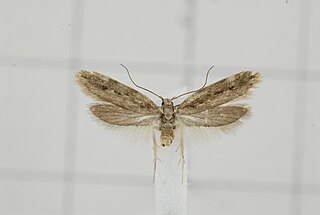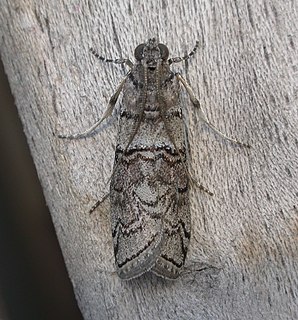The Tineodidae or false plume moths are a family of moths with in some cases unusually modified wings: Like in some related moths, the wings of several Tineodidae are decomposed into several rigid spines. This is a small family, with about a global total of 20 species described to date; some undescribed species are known or suspected to exist however. They seem to be of Australian origin, where they are most diverse, but range through the Wallacea to Southeast and South Asia, and into the Pacific to the Marquesas Islands.

Ethmiopsis is a genus of the twirler moth family (Gelechiidae). Among these, it was previously assigned to subfamily Pexicopiinae, but later moved to the Chelariini tribe.
Pityocona is a small and little-known genus of the twirler moth family (Gelechiidae). Among these, it is believed to belong to subfamily Gelechiinae, but beyond that its relationships are still obscure.

Crocidosema plebejana, the cotton tipworm, is a tortrix moth, belonging to tribe Eucosmini of subfamily Olethreutinae. It is found today all over the subtropical and tropical regions of the world and even occurs on many oceanic islands – in Polynesia and Saint Helena for example – but has probably been accidentally introduced to much of its current range by humans. In addition, it is also found in some cooler regions, e.g. in Europe except in the east and north; this is probably also not natural, as it was, for example, not recorded in the British Isles before 1900.
Chrysophyllis is a genus of the grass moth family (Crambidae). It is monotypic, containing the single species Chrysophyllis lucivaga. This moth is very little known, having only been recorded once, before 1935. It belongs to the large grass moth subfamily Spilomelinae; at the time of its description, these were still included in subfamily Pyraustinae and the entire Crambidae was then merged with the snout moths. While its exact relationships are undetermined, it is believed to be a close relative of Talanga. Like these, the male genitalia of C. lucivaga feature a remarkably elongated aedeagus shaped like a bullwhip.
Asymphorodes is a gelechioid moth genus in subfamily Agonoxeninae of the palm moth family (Agonoxenidae), whose taxonomic status is disputed. Alternatively, the palm moths might be a subfamily of the grass-miner moth family (Elachistidae), with the Agonoxeninae becoming a tribe Agonoxenini.
Herlinda is a genus of cosmet moths. These moths were only discovered in 1968 and the genus was not described until 1986; its affiliations within the family are presently unknown. This genus, as far as is known, is endemic to the Marquesas Islands of Polynesia, with each species confined to a single island.
Iressa is a genus of cosmet moths. It belongs to subfamily Cosmopteriginae.
Melnea is a gelechioid moth genus usually placed in the cosmet moth family (Cosmopterigidae); its exact relationships are not yet resolved however. Only a single species is known, Melnea armigera. It ranges widely in insular Melanesia and southern Polynesia. Furthermore it had been recorded from the Mauritius, Seychelles and Réunion. Its distribution is the result of accidental introductions by human travellers but its hostplant remains unknown.

Opogona is a genus of the fungus moth family, Tineidae. Therein, it belongs to the subfamily Hieroxestinae. As it includes Opogona omoscopa, the type species of the now-abolished genus Hieroxestis, it is the type genus of its subfamily.
Catalectis is a small genus of the fungus moth family, Tineidae. It is a small and little-studied group, whose precise relationships remain to be discovered. C. pharetropa was once mistaken for a species of Clepticodes, and Oenoe drosoptila of the Meessiinae was also proposed as a species of Catalectis; ít may be that these are all, in fact, closely related.
Terthroptera is a genus of ermine moths. They belong to the large subfamily Yponomeutinae.
Noduliferola is a genus of tortrix moths belonging to the tribe Eucosmini of subfamily Olethreutinae. The known species range from East Asia to Polynesia.

Cadra is a genus of small moths belonging to the family Pyralidae. The genus Ephestia is closely related to Cadra and might be its senior synonym. Several of these moths are variously assigned to one or the other genus, in particular in non-entomological sources. Cadra and Ephestia belong to the huge snout moth subfamily Phycitinae, and therein to the tribe Phycitini.
Anatrachyntis incertulella, the pandanus flower moth, is a small cosmet moth species. It belongs to subfamily Cosmopteriginae. This was the first "micromoth" species to be described from Hawaiʻi. The type specimens were collected there by the 1820s Beechey expedition and described by the English entomologist Francis Walker in 1864; they are now in the British Museum of Natural History.

Stoeberhinus testaceus, the potato moth, is a gelechioid moth, supposedly the only species of its genus Stoeberhinus. However, the genus might also include some related moths presently placed in Autosticha. It belongs to the subfamily Autostichinae, which is either placed in the concealer moth family (Oecophoridae), or in an expanded Autostichidae.
Ernophthora is a genus of small moths belonging to the snout moth family (Pyralidae). They form part of the Cabniini, a rather small tribe of the huge snout moth subfamily Phycitinae. This genus is generally found in the Australia-Pacific region.

Assara is a genus of small moths belonging to the snout moth family (Pyralidae). They are part of the tribe Phycitini within the huge snout moth subfamily Phycitinae.

Ctenomeristis is a genus of small moths belonging to the snout moth family (Pyralidae). They are part of the tribe Phycitini within the huge snout moth subfamily Phycitinae.
Zamagiria is a genus of small moths belonging to the snout moth family (Pyralidae). They are part of the huge snout moth subfamily Phycitinae, but their exact relationships are obscure, and they are currently not assigned to a particular tribe of Phycitinae.






